中国传统节日英文介绍
- 格式:docx
- 大小:67.85 KB
- 文档页数:7
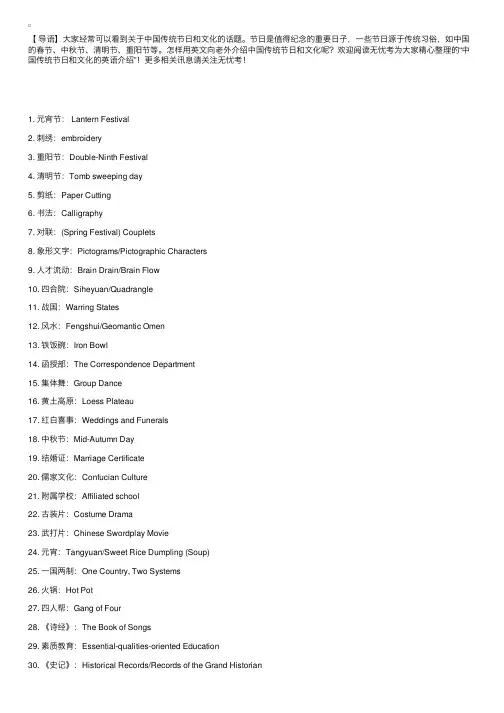
【导语】⼤家经常可以看到关于中国传统节⽇和⽂化的话题。
节⽇是值得纪念的重要⽇⼦,⼀些节⽇源于传统习俗,如中国的春节、中秋节、清明节、重阳节等。
怎样⽤英⽂向⽼外介绍中国传统节⽇和⽂化呢?欢迎阅读⽆忧考为⼤家精⼼整理的“中国传统节⽇和⽂化的英语介绍”!更多相关讯息请关注⽆忧考!1. 元宵节: Lantern Festival2. 刺绣:embroidery3. 重阳节:Double-Ninth Festival4. 清明节:Tomb sweeping day5. 剪纸:Paper Cutting6. 书法:Calligraphy7. 对联:(Spring Festival) Couplets8. 象形⽂字:Pictograms/Pictographic Characters9. ⼈才流动:Brain Drain/Brain Flow10. 四合院:Siheyuan/Quadrangle11. 战国:Warring States12. 风⽔:Fengshui/Geomantic Omen13. 铁饭碗:Iron Bowl14. 函授部:The Correspondence Department15. 集体舞:Group Dance16. 黄⼟⾼原:Loess Plateau17. 红⽩喜事:Weddings and Funerals18. 中秋节:Mid-Autumn Day19. 结婚证:Marriage Certificate20. 儒家⽂化:Confucian Culture21. 附属学校:Affiliated school22. 古装⽚:Costume Drama23. 武打⽚:Chinese Swordplay Movie24. 元宵:Tangyuan/Sweet Rice Dumpling (Soup)25. ⼀国两制:One Country, Two Systems26. ⽕锅:Hot Pot27. 四⼈帮:Gang of Four28. 《诗经》:The Book of Songs29. 素质教育:Essential-qualities-oriented Education30. 《史记》:Historical Records/Records of the Grand Historian31. ⼤跃进:Great Leap Forward (Movement)32. 《西游记》:The Journey to the West33. 除⼣:Chinese New Year’s Eve/Eve of the Spring Festival34. 针灸:Acupuncture35. 唐三彩:Tri-color Pottery of the Tang Dynasty/ The Tang Tri-colored pottery36. 中国特⾊的社会主义:Chinese-charactered Socialist/Socialist with Chinesecharacteristics37. 偏旁:radical38. 孟⼦:Mencius39. 亭/阁: Pavilion/ Attic40. ⼤中型国有企业:Large and Medium-sized State-owned Enterprises41. *:gunpowder42. 农历:Lunar Calendar43. 印/玺:Seal/Stamp44. 物质精神⽂明建设:The Construction of Material Civilization and Spiritual Civilization45. 京剧:Beijing Opera/Peking Opera46. 秦腔:Crying of Qin People/Qin Opera47. 太极拳:Tai Chi48. 独⽣⼦⼥证:The Certificate of One-child49. 天坛:Altar of Heaven in Beijing50. ⼩吃摊:Snack Bar/Snack Stand51. 红双喜:Double Happiness52. 政治辅导员:Political Counselor/School Counselor53. 春卷:Spring Roll(s)54. 莲藕:Lotus Root55. 追星族:Star Struck56. 故宫博物院:The Palace Museum57. 相声:Cross-talk/Comic Dialogue58. 下岗:Lay off/Laid off59. 北京烤鸭:Beijing Roast Duck60. ⾼等⾃学考试:Self-taught Examination of Higher Education61. *:fireworks and firecracker62. 敦煌莫⾼窟:Mogao Caves63. 电视⼩品:TV Sketch/TV Skit64. ⾹港澳门同胞:Compatriots from Hong Kong and Macao65. *:Cultural Revolution66. 长江中下游地区:The Mid-low Reaches of Yangtze River67. 门当户对:Perfect Match/Exact Match68. 《⽔浒》:Water Margin/Outlaws of the Marsh69. 中外合资企业:Joint Ventures70. ⽂房四宝(笔墨纸砚):"The Four Treasure of the Study" "Brush, Inkstick, Paper, and Inkstone"71.兵马俑:cotta Warriors/ Terracotta Army72.旗袍:cheongsam。
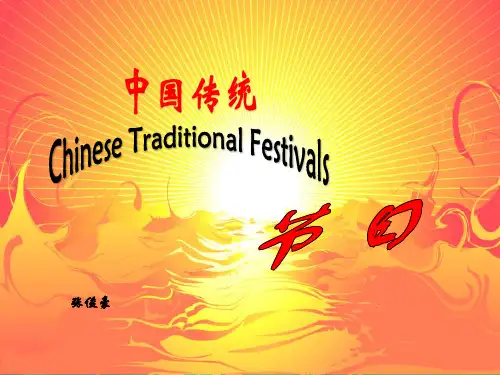
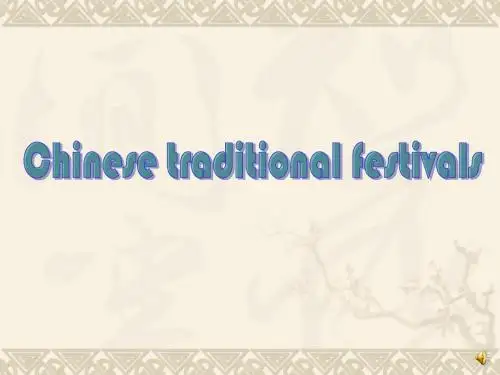
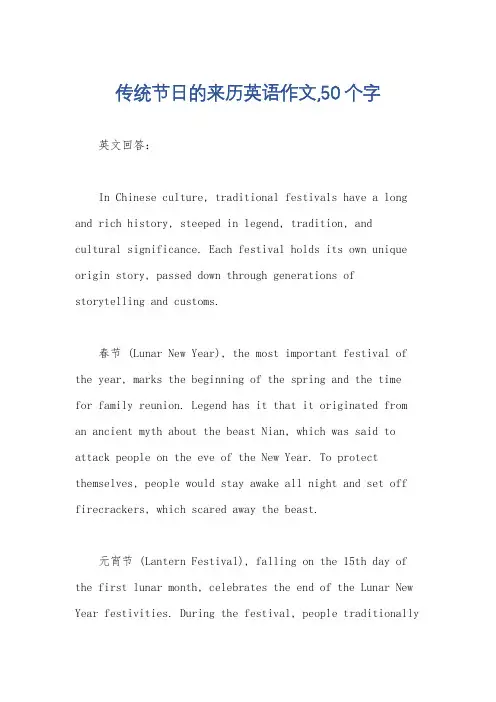
传统节日的来历英语作文,50个字英文回答:In Chinese culture, traditional festivals have a long and rich history, steeped in legend, tradition, andcultural significance. Each festival holds its own unique origin story, passed down through generations ofstorytelling and customs.春节 (Lunar New Year), the most important festival of the year, marks the beginning of the spring and the timefor family reunion. Legend has it that it originated from an ancient myth about the beast Nian, which was said to attack people on the eve of the New Year. To protect themselves, people would stay awake all night and set off firecrackers, which scared away the beast.元宵节 (Lantern Festival), falling on the 15th day of the first lunar month, celebrates the end of the Lunar New Year festivities. During the festival, people traditionallyrelease lanterns into the sky, symbolizing good luck and the breaking of darkness.清明节 (Qingming Festival), observed on the 15th day of the fourth lunar month, is a time to honor ancestors and pay respects to the deceased. It is believed that during this period, the gates of hell are open, allowing the spirits of the dead to visit the living world.端午节 (Dragon Boat Festival), held on the 5th day of the fifth lunar month, commemorates the ancient poet Qu Yuan. Legend has it that Qu Yuan, who was exiled for his political beliefs, drowned himself in the Miluo River. To honor his memory, people race dragon boats and eat zongzi, a type of sticky rice dumpling.中秋节 (Mid-Autumn Festival), falling on the 15th day of the eighth lunar month, celebrates the moon at its fullest. During the festival, people gather with their families to eat mooncakes and enjoy the full moon.重阳节 (Double Ninth Festival), observed on the 9th dayof the ninth lunar month, is a day to honor the elderly and show respect for longevity. It is believed that climbing high mountains on this day brings good health and fortune.这些只是中国众多传统节日中的一小部分。
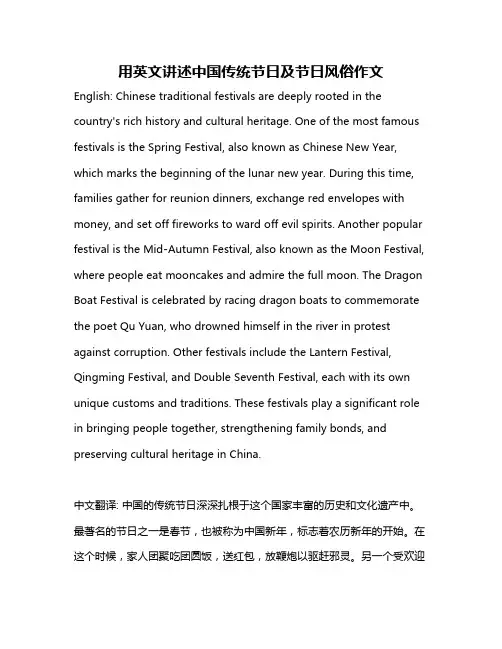
用英文讲述中国传统节日及节日风俗作文English: Chinese traditional festivals are deeply rooted in the country's rich history and cultural heritage. One of the most famous festivals is the Spring Festival, also known as Chinese New Year, which marks the beginning of the lunar new year. During this time, families gather for reunion dinners, exchange red envelopes with money, and set off fireworks to ward off evil spirits. Another popular festival is the Mid-Autumn Festival, also known as the Moon Festival, where people eat mooncakes and admire the full moon. The Dragon Boat Festival is celebrated by racing dragon boats to commemorate the poet Qu Yuan, who drowned himself in the river in protest against corruption. Other festivals include the Lantern Festival, Qingming Festival, and Double Seventh Festival, each with its own unique customs and traditions. These festivals play a significant role in bringing people together, strengthening family bonds, and preserving cultural heritage in China.中文翻译: 中国的传统节日深深扎根于这个国家丰富的历史和文化遗产中。
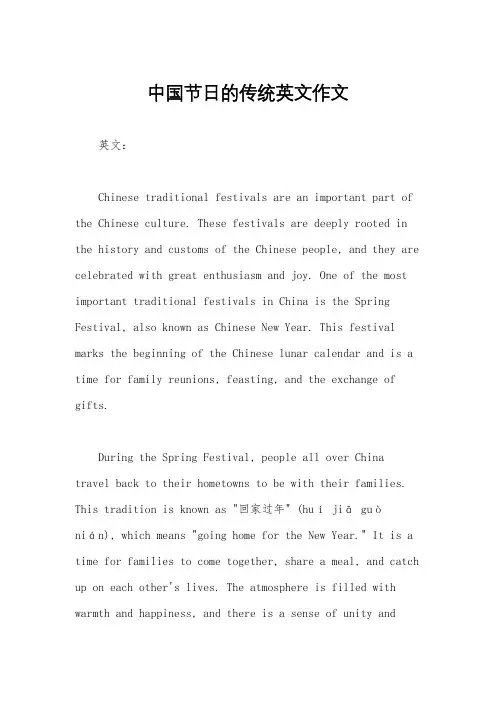
中国节日的传统英文作文英文:Chinese traditional festivals are an important part of the Chinese culture. These festivals are deeply rooted in the history and customs of the Chinese people, and they are celebrated with great enthusiasm and joy. One of the most important traditional festivals in China is the Spring Festival, also known as Chinese New Year. This festival marks the beginning of the Chinese lunar calendar and is a time for family reunions, feasting, and the exchange of gifts.During the Spring Festival, people all over Chinatravel back to their hometowns to be with their families. This tradition is known as "回家过年" (huí jiā guònián), which means "going home for the New Year." It is a time for families to come together, share a meal, and catch up on each other's lives. The atmosphere is filled with warmth and happiness, and there is a sense of unity andtogetherness that is truly heartwarming.Another important traditional festival is the Mid-Autumn Festival, also known as the Moon Festival. This festival is celebrated on the 15th day of the 8th month in the lunar calendar, when the moon is at its fullest and brightest. Families and friends gather to admire the moon and eat mooncakes, a traditional Chinese pastry filled with sweet bean paste or lotus seed paste. It is a time for expressing gratitude and love, and for enjoying the beauty of the moon together.In addition to these major festivals, there are also many other traditional Chinese festivals, such as the Dragon Boat Festival, the Lantern Festival, and the Double Seventh Festival. Each festival has its own unique customs and traditions, but they all share the common theme of bringing people together and celebrating the richness of Chinese culture.中文:中国传统节日是中国文化的重要组成部分。
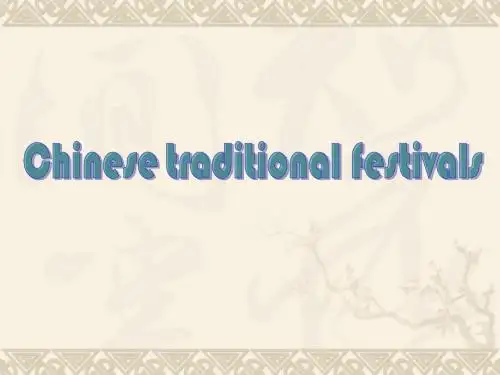
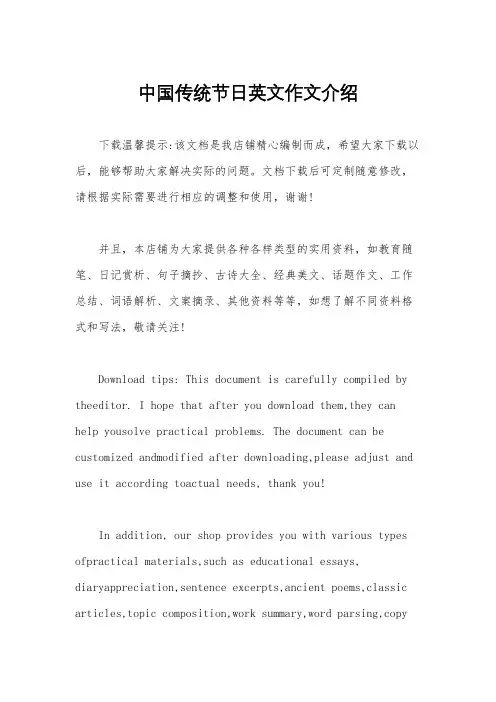
中国传统节日英文作文介绍下载温馨提示:该文档是我店铺精心编制而成,希望大家下载以后,能够帮助大家解决实际的问题。
文档下载后可定制随意修改,请根据实际需要进行相应的调整和使用,谢谢!并且,本店铺为大家提供各种各样类型的实用资料,如教育随笔、日记赏析、句子摘抄、古诗大全、经典美文、话题作文、工作总结、词语解析、文案摘录、其他资料等等,如想了解不同资料格式和写法,敬请关注!Download tips: This document is carefully compiled by theeditor. I hope that after you download them,they can help yousolve practical problems. The document can be customized andmodified after downloading,please adjust and use it according toactual needs, thank you!In addition, our shop provides you with various types ofpractical materials,such as educational essays, diaryappreciation,sentence excerpts,ancient poems,classic articles,topic composition,work summary,word parsing,copyexcerpts,other materials and so on,want to know different data formats andwriting methods,please pay attention!Chinese traditional festivals are an important part of Chinese culture. These festivals are often based on lunar calendar and have been celebrated for thousands of years. Each festival has its own unique customs, traditions and significance.One of the most important Chinese traditional festivals is the Spring Festival, also known as Chinese New Year. It is a time for family reunion, when people gather to have a big dinner, exchange gifts and red envelopes, and set off fireworks. The festival lasts for 15 days, during which people visit each other's homes and wish each other good luck and prosperity for the coming year.Another popular festival is the Mid-Autumn Festival, also known as the Moon Festival. It is a time for family members to gather and enjoy the full moon while eating mooncakes. People also light lanterns and participate in various cultural activities, such as dragon dances andtraditional performances.The Dragon Boat Festival, also known as Duanwu Festival, is celebrated by racing dragon boats and eating sticky rice dumplings, called zongzi. The festival commemorates the death of the poet and minister Qu Yuan, who drowned himself in the Miluo River. People also hang up calamus and wormwood leaves to ward off evil spirits.The Lantern Festival marks the end of the Chinese New Year celebrations. People celebrate by lighting and appreciating lanterns, solving riddles on the lanterns, and eating yuanxiao, a kind of sweet rice ball. It is also a time for lion and dragon dances, as well as othertraditional performances.These are just a few examples of the many traditional festivals in China. Each festival has its own unique customs and traditions, but they all share the common theme of bringing people together and celebrating the richcultural heritage of China.。
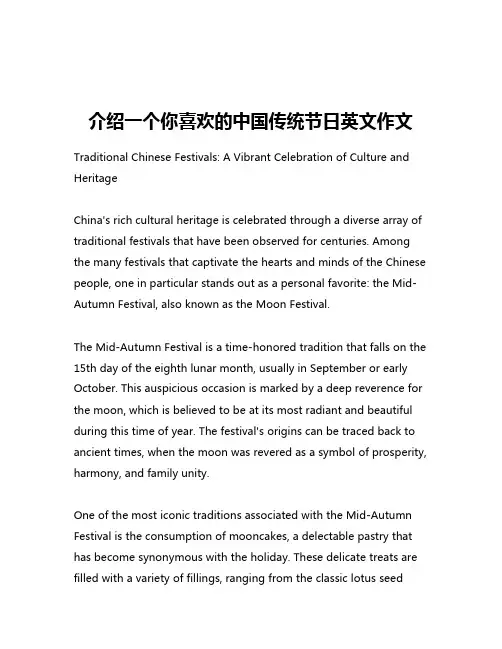
介绍一个你喜欢的中国传统节日英文作文Traditional Chinese Festivals: A Vibrant Celebration of Culture and HeritageChina's rich cultural heritage is celebrated through a diverse array of traditional festivals that have been observed for centuries. Among the many festivals that captivate the hearts and minds of the Chinese people, one in particular stands out as a personal favorite: the Mid-Autumn Festival, also known as the Moon Festival.The Mid-Autumn Festival is a time-honored tradition that falls on the 15th day of the eighth lunar month, usually in September or early October. This auspicious occasion is marked by a deep reverence for the moon, which is believed to be at its most radiant and beautiful during this time of year. The festival's origins can be traced back to ancient times, when the moon was revered as a symbol of prosperity, harmony, and family unity.One of the most iconic traditions associated with the Mid-Autumn Festival is the consumption of mooncakes, a delectable pastry that has become synonymous with the holiday. These delicate treats are filled with a variety of fillings, ranging from the classic lotus seedpaste to more contemporary flavors like red bean, egg yolk, or even fruit-based fillings. The mooncake's round shape is believed to represent the fullness and completeness of the moon, symbolizing the unity and harmony of family and community.Another integral aspect of the Mid-Autumn Festival is the lantern display. During the festival, intricate and colorful lanterns are hung in homes, streets, and public spaces, creating a mesmerizing and enchanting atmosphere. The lanterns come in a wide array of shapes and designs, often featuring traditional Chinese motifs and symbols, such as the iconic Chinese dragon or the graceful lotus flower. The lighting of these lanterns is not only a beautiful spectacle but also a symbolic gesture, representing the illumination of the soul and the dispelling of darkness.Perhaps one of the most captivating traditions of the Mid-Autumn Festival is the practice of moon-watching. As the sun sets and the moon rises, families and friends gather together to admire the moon's serene beauty and reflect on the significance of the occasion. This ritual is often accompanied by the sharing of moon-themed stories, poetry, and songs, as well as the consumption of mooncakes and other festive delicacies.The celebration of the Mid-Autumn Festival is not limited to China; it is also observed in other parts of Asia, including Taiwan, Singapore,and Malaysia, where the Chinese cultural influence is strong. In these regions, the festival is celebrated with equal fervor, with each community adding its own unique traditions and customs to the festivities.Beyond the Mid-Autumn Festival, China is home to a vast array of other traditional festivals that showcase the depth and diversity of the country's cultural heritage. The Lunar New Year, also known as the Spring Festival, is a vibrant celebration that marks the beginning of a new year on the lunar calendar. During this time, families gather for feasts, exchange red envelopes filled with money, and participate in lively parades and fireworks displays.The Qingming Festival, or Tomb Sweeping Day, is a solemn occasion when people visit the graves of their ancestors, clean the tombs, and make offerings to honor their memory. The Dragon Boat Festival, celebrated with colorful dragon boat races, traditional rice dumplings, and ancient legends, is another celebration that has captivated the hearts of the Chinese people for centuries.Each of these traditional festivals carries with it a rich tapestry of cultural symbolism, customs, and rituals that reflect the deep-rooted values and beliefs of the Chinese people. They are not merely events to be observed but rather living, breathing expressions of a civilization that has endured for millennia, passing down its traditionsand heritage from one generation to the next.As the world becomes increasingly globalized, the preservation and celebration of these traditional festivals have become even more crucial. They serve as a powerful reminder of the importance of cultural identity, community, and the enduring spirit of human connection. By embracing and sharing these traditions, we can foster a greater understanding and appreciation of the diverse cultural landscape of China and the world at large.In conclusion, the Mid-Autumn Festival and the many other traditional Chinese festivals are not just events to be celebrated but rather a testament to the enduring strength and resilience of a rich and vibrant culture. They offer a glimpse into the heart and soul of the Chinese people, inviting us to embrace the timeless beauty and wisdom that lie at the core of these timeless traditions.。
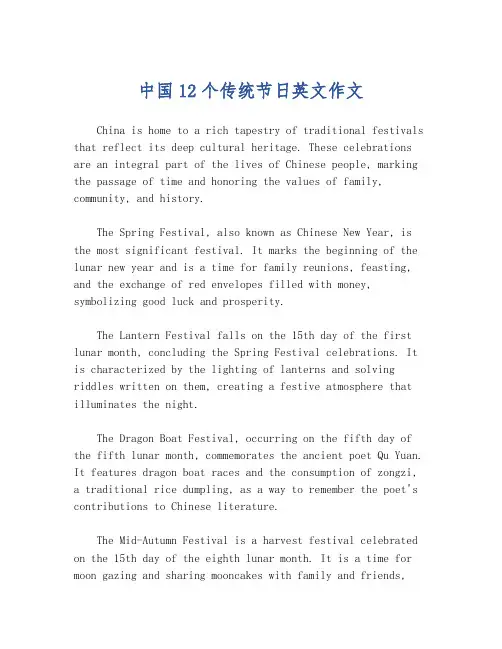
中国12个传统节日英文作文China is home to a rich tapestry of traditional festivals that reflect its deep cultural heritage. These celebrations are an integral part of the lives of Chinese people, marking the passage of time and honoring the values of family, community, and history.The Spring Festival, also known as Chinese New Year, is the most significant festival. It marks the beginning of the lunar new year and is a time for family reunions, feasting, and the exchange of red envelopes filled with money, symbolizing good luck and prosperity.The Lantern Festival falls on the 15th day of the first lunar month, concluding the Spring Festival celebrations. It is characterized by the lighting of lanterns and solving riddles written on them, creating a festive atmosphere that illuminates the night.The Dragon Boat Festival, occurring on the fifth day of the fifth lunar month, commemorates the ancient poet Qu Yuan. It features dragon boat races and the consumption of zongzi, a traditional rice dumpling, as a way to remember the poet's contributions to Chinese literature.The Mid-Autumn Festival is a harvest festival celebrated on the 15th day of the eighth lunar month. It is a time for moon gazing and sharing mooncakes with family and friends,signifying unity and togetherness.The Double Ninth Festival, also known as Chongyang, is a day for respecting the elderly and promoting longevity. It is customary to climb high places and wear dogwood, symbolizing health and long life.The Qingming Festival, or Tomb-Sweeping Day, is a day of remembrance for ancestors. Families visit graves to clean and make offerings, showing respect and keeping the memory of their loved ones alive.The Double Seventh Festival, also known as Qixi, is a romantic celebration akin to Valentine's Day in the West. It tells the tale of the Cowherd and the Weaver Girl, and is a time for lovers to express their affection.The Laba Festival is celebrated on the eighth day of the twelfth lunar month, marking the end of winter and the coming of spring. It involves the consumption of Laba porridge, a mixture of grains, nuts, and dried fruits, symbolizing good health and fortune.The Cold Food Festival is observed to remember Jie Zitui, who died in a fire while trying to save his mother. It is a day of fasting and remembrance, abstaining from cooking to honor his sacrifice.The Chinese New Year's Eve is the day before the Spring Festival, a time for family to gather for a reunion dinner, reflecting on the past year and looking forward to the newone with hope and joy.Each of these festivals is a testament to the enduring traditions and values of Chinese culture, providing a rich and vibrant backdrop to the lives of its people.。
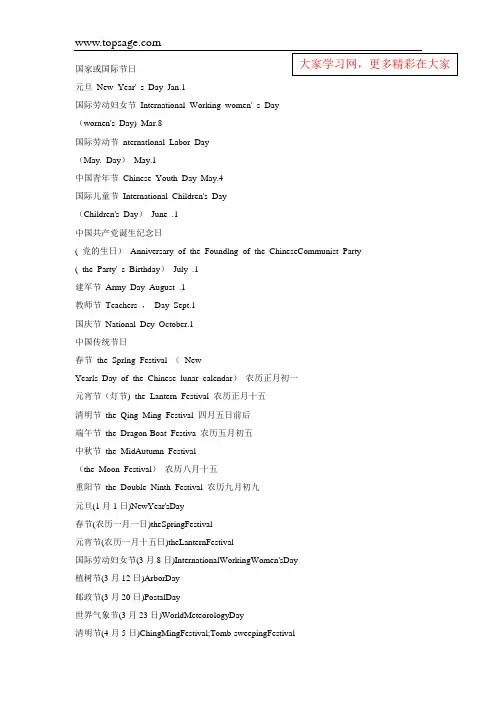
国家或国际节日元旦New Year' s Day Jan.1国际劳动妇女节International Working women' s Day(wornen's Day) Mar.8国际劳动节nternatlonal Labor Day(May. Day)May.1中国青年节Chinese Youth Day May.4国际儿童节International Children's Day(Children's Day)June .1中国共产党诞生纪念日( 党的生日)Anniversary of the Foundlng of the ChineseCommunist Party ( the Party' s Birthday)July .1建军节Army Day August .1教师节Teachers ,Day Sept.1国庆节National Dey October.1中国传统节日春节the Sprlng Festival (NewYearls Day of the Chinese lunar calendar)农历正月初一元宵节(灯节) the Lantern Festival 农历正月十五清明节the Qing Ming Festival 四月五日前后端午节the Dragon-Boat Festiva 农历五月初五中秋节the MidAutumn Festival(the Moon Festival)农历八月十五重阳节the Double Ninth Festival 农历九月初九元旦(1月1日)NewYear'sDay春节(农历一月一日)theSpringFestival元宵节(农历一月十五日)theLanternFestival国际劳动妇女节(3月8日)InternationalWorkingWomen'sDay植树节(3月12日)ArborDay邮政节(3月20日)PostalDay世界气象节(3月23日)WorldMeteorologyDay清明节(4月5日)ChingMingFestival;Tomb-sweepingFestival国际劳动节(5月1日)InternationalLabourDay中国青年节(5月4日)ChineseYouthDay护士节(5月12日)Nurses'Festival端午节(农历五月初五)theDragonBoatFestival国际儿童节(6月1日)InternationalChildren'sDay中国共产党成立纪念日(7月1日)theParty'sBirthday建军节(8月1日)theArmy'sDay中秋节(农历八月十五)Mid-autumn(Moon)Festival教师节(9月10日)Teachers'Day重阳节(农历九月九日)Double-ninthDay国庆节(10月1日)NationalDay除夕(农历十二月三十日)NewYear'sEve阳历节日1月1日元旦(New Year's Day)2月2日世界湿地日(World Wetlands Day)2月14日情人节(Valentine's Day)3月3日全国爱耳日3月5日青年志愿者服务日3月8日国际妇女节(International Women' Day)3月9日保护母亲河日3月12日中国植树节(China Arbor Day)3月14日白色情人节(White Day)3月14日国际警察日(International Policemen' Day)3月15日世界消费者权益日(World Consumer Right Day)3月21日世界森林日(World Forest Day)3月21日世界睡眠日(World Sleep Day)3月22日世界水日(World Water Day)3月23日世界气象日(World Meteorological Day)3月24日世界防治结核病日(World Tuberculosis Day)4月1日愚人节(April Fools' Day)4月5日清明节(Tomb-sweeping Day)4月7日世界卫生日(World Health Day)4月22日世界地球日(World Earth Day)4月26日世界知识产权日(World Intellectual Property Day)5月1日国际劳动节(International Labour Day)5月3日世界哮喘日(World Asthma Day)5月4日中国青年节(Chinese Youth Day)5月8日世界红十字日(World Red-Cross Day)5月12日国际护士节(International Nurse Day)5月15日国际家庭日(International Family Day)5月17日世界电信日(World Telecommunications Day)5月20日全国学生营养日5月23日国际牛奶日(International Milk Day)5月31日世界无烟日(World No-Smoking Day)6月1日国际儿童节(International Children's Day)6月5日世界环境日(International Environment Day)6月6日全国爱眼日6月17日世界防治荒漠化和干旱日(World Day to combat desertification)6月23日国际奥林匹克日(International Olympic Day)6月25日全国土地日6月26日国际禁毒日(International Day Against Drug Abuse and Illicit Trafficking)7月1日中国共产党诞生日(Anniversary of the Founding of the Chinese Communist Party) 7月1日国际建筑日(International Architecture Day)7月7日中国人民抗日战争纪念日7月11日世界人口日(World Population Day)8月1日中国人民解放军建军节(Army Day)8月12日国际青年节(International Youth Day)9月8日国际扫盲日(International Anti-illiteracy Day)9月10日中国教师节(Teacher's Day)9月16日中国脑健康日9月16日国际臭氧层保护日(International Day for the Preservation of the Ozone Layer) 9月20日全国爱牙日9月21日世界停火日(World Cease-fire Day)9月27日世界旅游日(World Tourism Day)10月1日中华人民共和国国庆节(National Day)10月1日国际音乐日(International Music Day)10月1日国际老年人日(International Day of Older Persons)10月4日世界动物日(World Animal Day)10月5日世界教师日(World Teachers' Day)(联合国教科文组织确立)10月8日全国高血压日10月9日世界邮政日(World Post Day)10月10日世界精神卫生日(World Mental Health Day)10月14日世界标准日(World Standards Day)10月15日国际盲人节(International Day of the Blind)10月15日世界农村妇女日(World Rural Women's Day)10月16日世界粮食日(World Food Day)10月17日国际消除贫困日(International Day for the Eradication of Poverty)10月24日联合国日(United Nations Day)10月24日世界发展新闻日(World Development Information Day)10月28日中国男性健康日10月29日国际生物多样性日(International Biodiversity Day)10月31日万圣节(Halloween)11月8日中国记者节11月9日消防宣传日11月14日世界糖尿病日(World Diabetes Day)11月17日国际大学生节11月25日国际消除对妇女的暴力日(International Day For the elimination of Violence agai nst Women)12月1日世界爱滋病日(World AIDS Day)12月3日世界残疾人日(World Disabled Day)12月4日全国法制宣传日12月9日世界足球日(World Football Day)12月25日圣诞节(Christmas Day)12月29日国际生物多样性日(International Biological Diversity Day)1月最后一个星期日国际麻风节3月最后一个完整周的星期一中小学生安全教育日春分月圆后的第一个星期日复活节(Easter Monday)(有可能是3月22-4月25日间的任一天) 5月第二个星期日母亲节(Mother's Day)5月第三个星期日全国助残日6月第三个星期日父亲节(Father's Day)9月第三个星期二国际和平日(International Peace Day)9月第三个星期六全国国防教育日9月第四个星期日国际聋人节(International Day of the Deaf)10月的第一个星期一世界住房日(World Habitat Day)10月的第二个星斯一加拿大感恩节(Thanksgiving Day)10月第二个星期三国际减轻自然灾害日(International Day for Natural Disaster Reduction) 10月第二个星期四世界爱眼日(World Sight Day)11月最后一个星期四美国感恩节(Thanksgiving Day)农历节日农历正月初一春节(the Spring Festival)农历正月十五元宵节(Lantern Festival)农历五月初五端午节(the Dragon-Boat Festival)农历七月初七乞巧节(中国情人节)(Double-Seventh Day)农历八月十五中秋节(the Mid-Autumn Festival)农历九月初九重阳节(the Double Ninth Festival)农历腊月初八腊八节(the laba Rice Porridge Festival)农历腊月二十四传统扫房日。
英语作文向外国朋友介绍中国传统节日端午节精选英文英语作文向外国朋友介绍中国传统节日端午节:Title: Introducing the Traditional Chinese Festival of Dragon Boat FestivalDear Foreign Friend,I am thrilled to introduce you to one of the most celebrated and culturally significant festivals in China - the Dragon Boat Festival, also known as the Double Fifth Festival. This festival, marked on the fifth day of the fifth lunar month, is not just a day of rejoicing but also a rich tapestry of traditions, history, and folklore.The Dragon Boat Festival has a profound historical background. It commemorates the ancient Chinese poet Qu Yuan, who was a minister during the Warring States period. When he saw the country being devastated by war and corruption, he felt dejected and threw himself into the Miluo River. The locals, in order to save him, paddled out in boats and threw rice dumplings into the river to feed the fish, hoping they would not eat Qu Yuan's body. This tradition has evolved into the exciting dragon boat races and the consumption of zongzi, or rice dumplings, during the festival.The dragon boat races are a highlight of the festival. Colorful dragon boats, adorned with vibrant dragon heads and tails, race across the water with teams of paddlers pulling together in unison. The cheering and excitement from the spectators create a festive atmosphere that is both exhilarating and contagious.Apart from the races, making and eating zongzi is another integral part of the festival. These triangular-shaped rice dumplings are wrapped in bamboo leaves and filled with avariety of ingredients such as red beans, meat, and egg yolks. Preparing zongzi with family and friends is a cherished tradition that brings people together.Moreover, the Dragon Boat Festival is also a time for hanging up calamus and wearing perfume sachets to ward off evil spirits and diseases. These customs, along with the dragon boat races and zongzi, form a unique cultural mosaic that represents the essence of the festival.In conclusion, the Dragon Boat Festival is not just a celebration but a window to China's rich cultural heritage. I hope this introduction has piqued your interest, and I encourage you to experience this festival firsthand when you visit China.Warm regards,[Your Name]中文对照翻译:标题:介绍中国传统节日端午节尊敬的外国朋友:,我很高兴向大家介绍中国最著名、zui具文化意义的节日之一——端午节,也被称为双五节。
中国传统节日介绍英文作文范文1China has many traditional festivals, which are rich in culture and meaning.The Spring Festival is one of the most important. Families get together to have a reunion dinner. People set off firecrackers to drive away evil spirits and welcome good luck.The Mid-Autumn Festival is a time for enjoying the full moon and eating mooncakes. It symbolizes family reunion and harmony.The Dragon Boat Festival features dragon boat races and eating zongzi. It commemorates a great ancient poet.These traditional festivals are not only a part of our history but also bring people together, strengthen family bonds, and pass on our values and traditions. They are precious treasures of our nation.2Hello everyone! Let me introduce some traditional Chinese festivals to you.The Spring Festival is the most important one. It usually comes in late January or early February. Families get together, having a big feast and setting off fireworks. People wear new clothes and give red envelopes to children for good luck.The Mid-Autumn Festival is in August. We enjoy the full moon and eat mooncakes. It's a time for family reunion.The Dragon Boat Festival is in June. We watch dragon boat races and make zongzi. It's very exciting.These festivals are not only fun but also full of deep meanings. I hope you can experience them one day!3These days, many traditional Chinese festivals seem to be fading from our memories. Take the Dragon Boat Festival as an example. Some people just think of it as a day off without really understanding its meaning and traditions.The main reason for this is the fast pace of modern life. We are so busy with work and study that we don't have much time to learn about and celebrate these festivals. Also, the influence of foreign cultures makes us pay less attention to our own traditions.To solve this problem, we should have more activities related to traditional festivals in schools and communities. We can organize competitions like making zongzi during the Dragon Boat Festival. The media should also play a role in promoting these festivals and telling people their importance. Let's work together to pass on our precious traditions to the next generations.4I still remember the Spring Festival I spent with my family last year. It was such a wonderful time.In the morning, I woke up early and helped my parents decorate the house with red lanterns and couplets. Everyone was in a happy mood. Then, we had a big lunch together. There were all kinds of delicious dishes on the table.In the evening, we sat around the TV and watched the Spring Festival Gala. When the clock struck twelve, we set off fireworks. The sky was lit up and it was so beautiful. I felt really excited and happy.This Spring Festival was full of joy and warmth. I love spending festivals with my family.5China has many traditional festivals with rich histories and unique customs. These festivals play an important role in our culture.The Spring Festival is the most important one. It marks the beginning of a new year. People clean their houses, have big meals, and give red envelopes as gifts. There's a legend that a monster named "Nian" was scared away by firecrackers.The Mid-Autumn Festival is also popular. Families get together to admire the full moon and eat mooncakes. It is said that Chang'e flew to themoon and lived there.These festivals not only bring joy but also pass on our traditions from generation to generation. They make us proud of our culture.。
中国传统节日No. 1 春节春节,也被称为农历新年。
对于中国人来说,这是规模最大,最重要的传统节日。
就如同西方的圣诞节一样,春节是一家团聚的日子。
The Spring Festival is also called Chinese Lunar New Year. Being one of the traditional Chinese festivals, it is the grandest and most important festival for Chinese people. It is also the time for whole families to get together, which is similar to Christmas for Westerners.春节从农历新年第一天开始,几乎要持续半个月。
但在民间传统中,这一节日从腊月23日就开始了,一直到正月十五(元宵节)。
It comes on the first day of Chinese lunar calendar and lasts for almost half of a month. But in folk custom, this traditional holiday lasts from the 23rd day of the twelfth month to the 15th day of the first month (The Lantern Festival) on the lunar calendar.大年三十(除夕夜):团圆饭就除夕夜而言,无论身在何处,也不管路途多么遥远,人们都会设法赶回家,所以除夕夜的盛大晚餐也叫做“团圆饭”。
每个家庭的团圆饭都是一年中精心准备的最华丽和隆重的家宴。
女主人在餐桌上摆满精心准备的食物,全家人围坐一起分享美味佳肴,然后一起乐融融地包饺子。
午夜12点,每个家庭都会放鞭炮,辞旧迎新。
中国传统节日英文作文1. Chinese traditional festivals are always full of joy and excitement. People gather together to celebrate, eat delicious food, and enjoy colorful decorations.2. During the Spring Festival, families reunite, fireworks light up the sky, and red lanterns hang on every door. It's a time for reflection and new beginnings.3. The Mid-Autumn Festival is all about mooncakes, lanterns, and admiring the full moon. Families sit together, eat mooncakes, and share stories under the moonlit sky.4. Dragon Boat Festival is a time for racing dragon boats, eating sticky rice dumplings, and honoring the ancient poet Qu Yuan. The sound of drums and cheers fillthe air.5. The Lantern Festival marks the end of the Chinese New Year celebrations. Streets are filled with colorfullanterns, lion dances, and people carrying glowing lanterns to symbolize hope and good luck.6. Qingming Festival is a time to honor ancestors, sweep their tombs, and enjoy the beauty of spring. It's a time to remember the past and appreciate the present.7. Double Ninth Festival is a time to climb mountains, drink chrysanthemum wine, and enjoy the autumn scenery.It's a time to appreciate nature and cherish the company of loved ones.8. Chinese traditional festivals are a reflection of the rich culture and history of China. They bring people together, create lasting memories, and remind us of the importance of tradition and community.。
向别人介绍我喜欢的中国传统节日英文作文全文共6篇示例,供读者参考篇1My Favorite Chinese Festival - The Mid-Autumn FestivalHi there! My name is Xiaoming and I'm 10 years old. I go to Peking Elementary School here in Beijing. Today I want to tell you all about my absolute favorite festival in China - theMid-Autumn Festival! It's a really fun and exciting time every year.The Mid-Autumn Festival happens on the 15th day of the8th month in the Chinese lunar calendar. That usually means it falls sometime in September or early October based on the Western calendar. This year it will be on September 29th.The festival celebrates the autumn moon, which is known as the brightest and fullest moon of the year. There are a bunch of cool traditions and activities around this special moon. My favorite part is getting together with my whole family to admire the bright full moon, eat delicious mooncakes, and carry brightly colored lanterns!Mooncakes are these really tasty pastries that are made especially for the Mid-Autumn Festival. They have a thin crust and are stuffed with different fillings like lotus seed paste, sweet bean paste, egg yolks, and more. The traditional mooncakes have an imprint on top that shows designs related to the festival like the moon, rabbits, the Lady of the Moon, or flowers. My grandma always buys boxes of different flavored mooncakes for us from the bakery before the festival. I can't wait to eat them!Another fun tradition is carrying beautifully decorated lanterns at night when the full moon is out. There are all kinds of creative lantern designs - rabbits, fish, spheres, even fancy electric lanterns that light up and change colors! My favorite is the rabbit lantern because the rabbit is one of the main stories connected to the moon in Chinese folklore.Speaking of folklore, there are a bunch of different legends and myths around the origins of the Mid-Autumn Festival. One popular story is about Chang'e, who is known as the Lady of the Moon. According to the myth, Chang'e drank an immortality elixir and floated up to become the moon goddess, leaving her husband Hou Yi alone on Earth. It's said that Hou Yi missed Chang'e so much that he left out her favorite foods likemooncakes and fruit as offerings to her spirit. That's why we eat mooncakes during the festival to remember this tale.Another legend explains the rabbit design you see on a lot of lanterns and mooncake imprints. It says that a rabbit lives on the moon as a companion to Chang'e. If you look closely at the patterns on the moon, you can make out the shape of a rabbit pounding herbs. Isn't that cool?Besides the amazing food and fun lantern activities, the Mid-Autumn Festival brings my whole family together which is the best part. We have a huge dinner with all my aunts, uncles, cousins, and grandparents at my house. After we finish eating, we all go outside and just spend time admiring the bright full moon together. We'll sing songs, tell stories, and walk around carrying our lanterns. It's such a magical night every year.At school, we also learned about the significance of the full moon in the Mid-Autumn Festival. Since ancient times, the full moon has symbolized prosperity, family reunion, and hope. Farmers would look to celebrate the upcoming fall harvest during the festival. Families would reunite and celebrate being together under the brightest moon of the year. I think that's why spending time with family is the most important part of this holiday.The Mid-Autumn Festival is also celebrated in other Asian countries besides China. In Vietnam it's called the Children's Festival or Tet Trung Thu. Kids get to join dragon dances, carry lanterns, and eat different types of mooncakes. I learned that in Korea it's called Chuseok and the major traditions involve family reunions, eating a delicious rice dish called songpyeon, and playing folk games.In Singapore and Malaysia, which have a lot of ethnic Chinese people, the Mid-Autumn Festival is also very popular. They have huge lantern displays, carnivals, and concerts in the streets during the celebration period. People gather for lantern riddles where they have to solve puzzles written on intricately designed lanterns. I think doing lantern riddles sounds like a ton of fun!One year, I remember my parents taking me and my little brother to Longtan Park here in Beijing for the Mid-Autumn Festival celebration. The entire park was decorated with thousands of colorfully lit lanterns hanging from trees and displayed on the ground. They had these massive lantern sculptures that looked like famous scenes and characters from history and mythology. My favorite was the enormous lantern dragon that seemed to slither through the park. I'll never forgetwalking under all those bright lanterns with my lantern glowing - it felt like a dreamworld!At the park festival, there were also tons of game booths set up where you could win little prizes. I played one of the fishing games with a little paperstring rod and won a few goldfish! We watched dancers perform with amazing lanterns and ate delicious festival snacks like candied hawthorn, flour tea, and sugar rabbits. I really hope we can go back to that amazingMid-Autumn Festival celebration at Longtan Park again sometime.I just love the traditions, stories, family activities, and fun surrounding this festival so much. The bright full moon, delicious mooncakes, lantern riddles and displays - it's such a unique and exciting time. To me, the Mid-Autumn Festival celebrates the importance of being together with loved ones, appreciating the beauty of nature, and keeping our rich cultural heritage alive through annual festivities and customs. I look forward to it every single year!Well, that's my overview of my favorite Chinese festival - the Mid-Autumn Festival! I hope you enjoyed learning about its history, symbolism, and all the fun traditions my family participates in. It really is the best time of the year if you ask me. Ican't wait to gorge on mooncakes, solve lantern riddles, and admire the beautiful harvest moon with my family again in just a few weeks. Thanks for reading, and let me know if you have any other questions!篇2My Favorite Traditional Chinese FestivalHi there! My name is Li Ming and I'm 10 years old. I love celebrating the traditional Chinese festivals with my family. There are so many fun ones throughout the year, but my absolute favorite is the Spring Festival, which you might know as Chinese New Year. Let me tell you all about it!The Spring Festival is the biggest and most important celebration in Chinese culture. It marks the start of a new year on the traditional Chinese calendar. The date changes every year, but it's always sometime in late January or early February based on the lunar cycle.Preparing for the Spring Festival is just as exciting as the actual holiday itself! For weeks beforehand, my whole family helps get our home ready. We do a thorough cleaning from top to bottom to sweep away any bad luck and make room for incoming good fortune. My mom buys lots of delicious festivalfoods like chicken, fish, dumplings, noodles, fruits, and candies. We decorate the house with red paper cutouts, couplets, and lanterns because red is considered a very lucky color that drives away evil spirits.On New Year's Eve, we have a huge reunion dinner with my grandparents, aunts, uncles, and cousins. It's my favorite meal of the whole year! We eat amazing foods like whole steamed fish (for surplus amounts of luck and prosperity), long noodles (for longevity), dumplings shaped like ancient Chinese money (for wealth), and niangao (a sticky sweet rice cake whose name sounds like "getting higher year by year"). While we eat, the kids receive red envelopes filled with "lucky money" from the elders.After dinner, we all stay up late to welcome the new year. The countdown to midnight is so exciting! We open all the doors and windows, turn on the lights, and light firecrackers and fireworks when the clock strikes twelve. The loud noises scare away any lingering bad luck from the old year. My favorite tradition is watching the amazing New Year's Gala show on TV with my family. It has dance performances, comedy acts, magic shows, and appearances by all the biggest celebrities.On the first day of the new year, I wake up early and put on my new clothes (it's considered bad luck to wear old clothes onthis day). First thing, I wish my parents "Xin Nian Kuai Le" which means "Happy New Year" and ask for their blessing. They give me more lucky red envelopes! Then my family burns incense and pays respect to our ancestors at the family altar. We spend the whole day visiting relatives and close family friends as a way to strengthen relationships. Everywhere we go, I hear phrases like "Gong Xi Fa Cai" which means "Wishing you prosperity in the new year!"Later in the Spring Festival season, there are lots of other fun activities like watching traditional lion and dragon dances, hanging colorful lanterns, eating tangyuan (sweet sticky rice balls), or going to crowded temple fairs with carnival games and snacks. My favorite part is the lantern festival on the 15th and final day, when children carry bright lanterns outside and try to guess riddles written on them.The Spring Festival celebrations go on for 15 days, all the way until the first full moon of the new year. It's such a joyful and festive time! Our whole country embraces the holiday spirit of spending quality time with loved ones, honoring ancestors, and wishing for good health, happiness, and prosperity in the coming year. All the vibrant red decorations, traditional foods, livelyfestivities, and warm family gatherings make the Spring Festival so special to me.While you may not celebrate Chinese New Year yourself, I hope you can see why I cherish this annual holiday so much. It's a time of hope, togetherness, gratitude, and excitement for a fresh start. If you ever get the chance to experience the Spring Festival in China, you absolutely should! The lively atmosphere is contagious and will definitely put a smile on your face. I look forward to it every single year.篇3My Favorite Chinese Festival: The Spring FestivalHi there! My name is Xiaoming and I'm a 4th grader at Beijing Elementary School. Today, I want to tell you all about my absolute favorite festival in China – the Spring Festival! It's also called Chinese New Year and it's the most important celebration in the Chinese culture.The Spring Festival is so much fun and there are many exciting traditions we follow. It usually takes place sometime in late January or early February, depending on the lunar calendar. The entire holiday period lasts about 23 days, but the main celebrations happen over the first 7 days of the new year.Let me tell you about all the cool things we do to get ready for the Spring Festival! A few weeks before the big day, my family starts cleaning our home from top to bottom. We want to sweep away all the bad luck篇4My Favorite Chinese Festival: The Spring FestivalHi everyone! My name is Xiaoming and I'm in 5th grade. Today, I want to tell you all about my absolute favorite holiday - the Spring Festival! It's the biggest and most important celebration in Chinese culture. We call it the Spring Festival, but you might know it as Chinese New Year. Every year, I look forward to this amazing festival with my whole heart!The Spring Festival always falls sometime between late January and mid-February, depending on the lunar calendar. The cool thing is that the date changes every year! The holiday lasts for about 2 weeks, with the biggest celebrations happening on New Year's Eve and the first few days of the new year. Families come together, houses get decorated, and everyone wears brand new clothes to start the year fresh.One of the most exciting parts is getting ready for the big family reunion dinner on New Year's Eve. My mom, dad,grandparents, aunts, uncles, and cousins all come over and we have the most scrumptious feast! The table is piled sky-high with dishes like dumplings, noodles, fish, meat, and veggies. We always make sure to have whole steamed fish because the Chinese word for "fish" sounds like the word for "surplus." So we eat it to hope for a surplus of everything good in the new year!After dinner, the real fun begins - staying up late to watch the nationwide New Year's Eve TV celebration broadcast! They have amazing performances, comedy shows, and the countdown to the new year. When midnight strikes, a huge display of fireworks and firecrackers goes off outside. The noise is deafening but I love it! We set off firecrackers too while shouting "Guo Nian Hao!" which means "Celebrate the new year!" It's such an exciting time full of hope for a fresh start.The first few days of the new year are also filled with traditions and festivities. We kids receive brand new red envelopes stuffed with cash from our parents and grandparents as a symbol of good luck. Yay, free money! We're not allowed to sweep the floors or take out the trash for a few days either, because you're not supposed to remove luck and prosperity from the home.Instead, we spend the first few days visiting friends and family, watching performances, eating way too many snacks, and just having a blast! Everywhere you look there are beautiful red lanterns hung up with lucky sayings and decorations. And of course, my favorite part is getting my new year's money to spend however I want!One of the coolest Spring Festival traditions is watching or participating in lion dances. These are dances performed by two people squeezing into an elaborate lion costume. The lion mimics a lucky and playful lion through different dance moves and interactions with a puppet figure. They're so much fun to watch, with the performers tumbling around in that huge costume! If they stop at your door, you're supposed to feed the lion some lettuce for good fortune.On the 15th day of the new year, we celebrate the Lantern Festival which signals the end of the Spring Festival season. My family always goes out to admire the beautiful lantern displays set up in parks and public squares. Some are huge colorful lanterns shaped like animals or buildings! We nibble on tangyuan, which are chewy rice ball dumplings rolled in sesame or crushed peanuts. Yum! At night, everyone is given a lantern to launch into the sky in hopes of good luck for the year ahead.Seeing all those bright lanterns drifting up into the night sky is such a magical sight.I just love the Spring Festival season so much! For two whole weeks, the streets seem brighter, everyone is happier, and the whole country comes together in celebrating family, hope, and good fortune for the brand new year. We take part in exciting traditions rooted in centuries of Chinese history and culture. From the decorations and clothes in lucky shades of red, to the food that symbolizes surplus and prosperity, to the fireworks that drive away bad luck - everything about the Spring Festival fills me with joy and appreciation for my heritage. I hope you enjoyed learning about my favorite holiday! Xin Nian Kuai Le (Happy New Year)!篇5My Favorite Chinese Festival - The Mid-Autumn FestivalHi everyone! My name is Xiaoming and I am 10 years old. Today, I want to tell you all about my absolute favorite holiday in China - the Mid-Autumn Festival! It's a really old tradition that we celebrate every year on the 15th day of the 8th month of the lunar calendar. That usually falls sometime in September or early October on the regular Western calendar.The Mid-Autumn Festival is also called the Moon Festival because it celebrates the full harvest moon, which is the biggest and brightest full moon of the year. I always look forward to this festival because there are so many fun activities and delicious foods involved!One of the main traditions is eating mooncakes. Mooncakes are these really tasty round pastries that are only made for this festival. They have a thick pastry crust on the outside and a sweet filling inside, usually with lotus seed paste or red bean paste. Some fancier mooncakes even have egg yolks baked into the middle to represent the full moon. My favorite part is the salted egg yolk in the center - it's so gooey and yummy!Every year in the weeks leading up to the Mid-Autumn Festival, you can find mooncake shops and street vendors everywhere selling different kinds of mooncakes. The packaging is always so pretty with colorful boxes decorated with images of the moon, rabbits, the Lady of the Moon, and other festive designs. My parents buy boxes of mooncakes as gifts to give to our relatives, neighbors, teachers, and friends. Giving out mooncakes is a way to wish others a happy festival and share your good fortune.Of course, once we receive the mooncake gift boxes, my sister and I can't wait to dig in! We beg my mom to let us have one right away even before the actual festival day arrives. Eating too many mooncakes in one sitting will definitely make your tummy hurt though. That's why we're only allowed to have one small piece each day.Another fun tradition is making and lighting lanterns. Lanterns are hung everywhere during this festival to symbolize bringing brightness into the world. My grandma always takes me to the park in the evening to see all the beautifully lit lanterns in different colors and shapes like rabbits, butterflies, dragons, and more. Some lanterns even have little riddles written on them that you have to solve!My favorite part is when we make our own lanterns at home. We use brightly colored papers or cellophane and bamboo strips to construct the lantern frame. Then we decorate the outside with drawings, cut-outs, tassels, and paint. Once it gets dark outside, we carefully light a candle inside the lantern and hang it up. It's so magical seeing our homemade lanterns glowing in the night. My sister and I always make a wish while looking up at the full moon when we light our lanterns.In some cities, there are big lantern festival parades and competitions where people make huge elaborate lanterns and everyone walks along carrying their lanterns and singing songs. Those lantern sculptures are like works of art - I've seen ones that look like famous temples, animals, even spaceships! The artistry is just amazing. I hope I can join the big lantern parade when I'm older.Another activity I really enjoy is eating pomelos and pomander fruits, which are closely tied to this festival too. Pomelos are a type of really big grapefruit that my grandparents always buy for us during this season. We play a fun game where we have to skillfully peel off one whole section of the thick pomelo rind without breaking the membrane. It's actually harder than it looks! If you can get a whole unbroken section of rind off, it's supposed to bring you good luck.Pomanders are those fruits that have been dried out and stuck with tons of cloves all over until they are completely covered. They make the house smell so fragrant and spicy. My mom hangs pomanders in all the rooms during the festival. She says it's to bring good fortune into our home. I just think they look and smell really cool!On the night of the actual Mid-Autumn Festival, the whole family gets together for a big celebratory meal. We have all kinds of tasty dishes, but my favorite is moon-shaped dumplings stuffed with lotus seed paste, ground meat, mushrooms, and vegetables. Yum! After our bellies are full, we go outside and find a spot to look up at the bright full harvest moon together. It's a symbol of reunion and togetherness for families.I also really enjoy the legends and folktales that get told during this festival about the moon goddess Chang'e, her husband Hou Yi the heroic archer, and their pet jade rabbit who lives on the moon. There are different versions but they all involve Hou Yi being rewarded with an elixir of immortality. But then Chang'e ends up drinking it by accident or to keep it away from someone evil. So she becomes a goddess and floats up to live on the moon for eternity! That's why you can see her dancing figure in the moon's shadows. There's also the jade rabbit who is her companion and guards her palace, and he's always pounding the elixir of immortality in a big mortar for Chang'e. My grandma knows so many fun stories about them that she tells us while we eat mooncakes under the moonlight.Well, those are some of the best parts of the Mid-Autumn Festival for me - the delicious mooncakes, the beautiful lanterns,the pomelos and pomanders, the moon-themed foods, the family togetherness, and all the ancient legends. It's definitely my most favorite time of the year because it combines so many fun traditions that I look forward to every autumn. I hope you enjoyed learning about this special Chinese festival! Let me know if you have any other questions.篇6My Favorite Chinese Festival - The Dragon Boat FestivalHi there! My name is Xiaoming and I'm going to tell you all about my favorite Chinese festival. It's called the Dragon Boat Festival and it's one of the most exciting times of the year! Every year on the 5th day of the 5th month of the lunar calendar, we celebrate this awesome holiday. Let me explain why I love it so much.First of all, the story behind the Dragon Boat Festival is really cool. A long, long time ago, there was this very smart and loyal guy named Qu Yuan. He served in the royal court, but he got exiled because some other officials got jealous of him and lied about him to the king. How mean is that?Anyway, Qu Yuan was so sad about being kicked out that he walked into a river and drowned himself. When the people livingnearby heard about it, they raced out in their boats to try and save him. They beat drums and splashed the water with their paddles, hoping to scare away any evil spirits lurking there.Even though they couldn't save the great Qu Yuan, people remembered him by drinking realgar wine, which was his favorite. They also wrapped some rice up in silk packages and threw them in the river so the fish wouldn't eat his body. Those rice packages are what we now call zongzi!So every Dragon Boat Festival, we eat zongzi dumplings, drink realgar wine, and have dragon boat races to honor Qu Yuan's sacrifice and keep his spirit alive. Watching the dragon boat competitions is definitely the most fun part for me.The boats are soooo cool looking! They are colorfully painted with designs of dragon heads and tails at each end. The crew members have to work together perfectly to paddle in sync and steer the boat. Races can get really intense with dozens of boats fighting for first place.My favorite part is seeing the ornately dressed drummers sitting at the front, beating in rhythm to the paddlers. The drums are decorated with dragon carvings too. The thundering rhythm and splashing water gets my heart pumping with excitement! I dream of being a drummer on a dragon boat when I'm older.After the races, there are always fun activities and performances like Chinese opera, lion dances, and eating contests for zongzi. Zongzi are delicious sticky rice dumplings wrapped up in bamboo leaves. They can have different fillings like egg, mushrooms, pork, or red bean paste. My mom makes the most amazing zongzi every year - they're my favorite festival food!At night, we light hanging lanterns and set off firecrackers to scare away any lingering evil spirits. The fireworks are so bright and loud, blasting different colors across the sky. Some kids wear special hats made of reeds and sedge to get good luck and health for the year. We sing folk songs too, celebrating thepatriotic poet Qu Yuan.My personal tradition is to tie a silk string around my ankles, which is supposed to keep me safe. I believe it works because one year I forgot, and I fell off my bike and scraped my knee! Now I never miss tying the strings. Another fun ritual is standing on eggs to get stronger legs - you're not allowed to break any eggs while standing on them!I also really enjoy the dragon boat festival because school is out and it finally starts to get hot outside after spring. My friends and I have waterfighting battles, trying to soak each other withbuckets of water. The ice cream vendors come out too, selling my favorite flavors like red bean and lychee. We run around chasing each other, faces stuffed with sticky rice balls and dripping ice cream. Those are the sweetest summer memories.At the end of the Dragon Boat Festival, we clean our houses from top to bottom, getting rid of any bad luck or misfortune from the past year. We tidy up to get ready for the new year ahead with a fresh start. It's like our own personal "New Year's" celebration after the big one in winter. I feel so rejuvenated andgrateful for life!That's why the Dragon Boat Festival is my absolute favorite time of year. The exciting boat races, delicious foods, lively performances, and special traditions make it so unique and fun. But most importantly, it reminds me of the inspiring ancient poet Qu Yuan and his loyalty to his country. His noble spirit fills me with Chinese pride.I hope you can experience the Dragon Boat Festival for yourself someday. Its rich cultural meaning combined with all the festivities make it a holiday you'll never forget. Grab a zongzi, put on your reed hat, and get ready to cheer on those brave dragon boat racers!。
中国的传统节日英文作文Chinese traditional festivals are full of rich cultural significance and unique customs. People celebrate these festivals with various activities and rituals, such as eating special foods, setting off fireworks, and wearing traditional costumes. These festivals are a time for families to come together, honor their ancestors, and pray for good fortune.One of the most famous traditional festivals in China is the Spring Festival, also known as Chinese New Year. It is a time for people to clean their homes, decorate with red lanterns and couplets, and eat dumplings and fish for good luck. The highlight of the Spring Festival is the reunion dinner on New Year's Eve, where families gather to enjoy a feast and watch the annual CCTV Spring Festival Gala.Another important festival is the Mid-Autumn Festival, also known as the Moon Festival. People celebrate by eatingmooncakes, admiring the full moon, and spending time with their loved ones. It is a time to give thanks for the harvest and pray for a bountiful year ahead.The Dragon Boat Festival is another traditional holiday that commemorates the poet Qu Yuan. People eat sticky rice dumplings, race dragon boats, and hang up pouches of herbs to ward off evil spirits. It is a lively and colorful festival that showcases China's rich cultural heritage.In addition to these major festivals, there are many other traditional holidays in China, such as the Lantern Festival, Qingming Festival, and Double Ninth Festival. Each festival has its own unique customs and traditions, but they all share a common theme of celebrating family, community, and cultural heritage.Overall, Chinese traditional festivals are a time for people to come together, honor their heritage, and celebrate the changing seasons. They are an important part of Chinese culture and continue to be cherished and celebrated by people all over the world.。
矿产资源开发利用方案编写内容要求及审查大纲
矿产资源开发利用方案编写内容要求及《矿产资源开发利用方案》审查大纲一、概述
㈠矿区位置、隶属关系和企业性质。
如为改扩建矿山, 应说明矿山现状、
特点及存在的主要问题。
㈡编制依据
(1简述项目前期工作进展情况及与有关方面对项目的意向性协议情况。
(2 列出开发利用方案编制所依据的主要基础性资料的名称。
如经储量管理部门认定的矿区地质勘探报告、选矿试验报告、加工利用试验报告、工程地质初评资料、矿区水文资料和供水资料等。
对改、扩建矿山应有生产实际资料, 如矿山总平面现状图、矿床开拓系统图、采场现状图和主要采选设备清单等。
二、矿产品需求现状和预测
㈠该矿产在国内需求情况和市场供应情况
1、矿产品现状及加工利用趋向。
2、国内近、远期的需求量及主要销向预测。
㈡产品价格分析
1、国内矿产品价格现状。
2、矿产品价格稳定性及变化趋势。
三、矿产资源概况
㈠矿区总体概况
1、矿区总体规划情况。
2、矿区矿产资源概况。
3、该设计与矿区总体开发的关系。
㈡该设计项目的资源概况
1、矿床地质及构造特征。
2、矿床开采技术条件及水文地质条件。